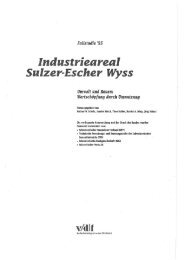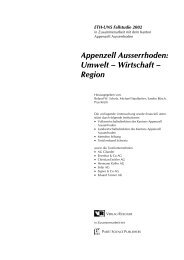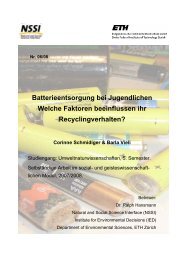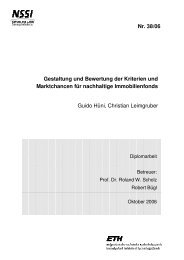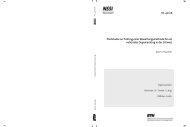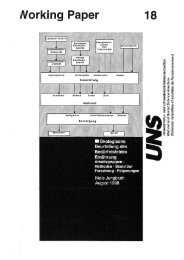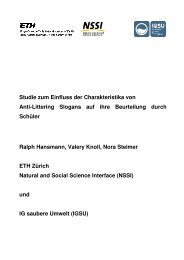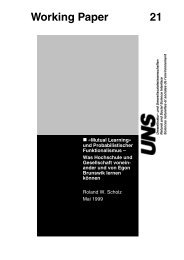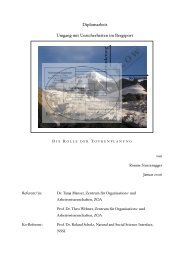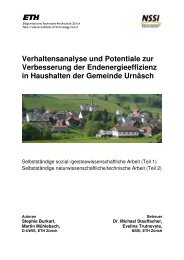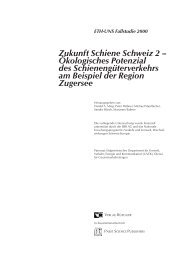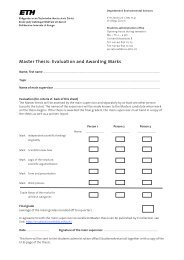Non-road fuel consumption and pollutant emissions ... - BAFU - CH
Non-road fuel consumption and pollutant emissions ... - BAFU - CH
Non-road fuel consumption and pollutant emissions ... - BAFU - CH
Create successful ePaper yourself
Turn your PDF publications into a flip-book with our unique Google optimized e-Paper software.
9 > Supplementary observations 103<br />
Tab. 12 > Comparison between the non-<strong>road</strong> segment <strong>and</strong> <strong>road</strong> traffic in 2005<br />
<strong>Non</strong>-<strong>road</strong> segment<br />
[tonnes p.a.]<br />
Road traffic<br />
[tonnes p.a.]<br />
Proportion of non-<strong>road</strong> segment to<br />
overall level (non-<strong>road</strong> + <strong>road</strong>)<br />
Consumption<br />
Diesel 333,300 1,393,400 19%<br />
Petrol 50,600 3,195,600 2%<br />
Energy 16.7 PJ 195 PJ 8%<br />
Pollutant <strong>emissions</strong><br />
Carbon monoxide (CO) 45,100 196,000 19%<br />
Hydrocarbons (HC) 6,510 19,800 25%<br />
Nitrogen oxides (NOX) 12,700 41,700 23%<br />
Particulate matter (PM) 887 1,390 39%<br />
Carbon dioxide (CO2) 1,230,000 14,400,000 8%<br />
Figures rounded up/down. Source for <strong>road</strong> traffic: SAEFL 2004<br />
This correlation also becomes apparent when we compare <strong>pollutant</strong> <strong>emissions</strong> <strong>and</strong> <strong>fuel</strong><br />
<strong>consumption</strong>. Table 13 shows average specific <strong>pollutant</strong> <strong>emissions</strong> (<strong>emissions</strong> per level<br />
of <strong>fuel</strong> <strong>consumption</strong> in g per kg) from non-<strong>road</strong> machines <strong>and</strong> <strong>road</strong> vehicles <strong>and</strong> directly<br />
compares them with one another. As we can see, on average the emission factors<br />
for non-<strong>road</strong> machines are several times higher than those for <strong>road</strong> vehicles. The<br />
differences are especially pronounced in the case of petrol engines, mainly because of<br />
the high proportion of 2-stroke engines used in non-<strong>road</strong> petrol-powered appliances<br />
(almost 20% of non-<strong>road</strong> petrol <strong>consumption</strong> is attributable to 2-stroke engines, in <strong>road</strong><br />
traffic it is only 0.6%). With diesel engines the specific <strong>emissions</strong> (nitrogen oxides <strong>and</strong><br />
PM) of non-<strong>road</strong> machines are 2 to 3 times higher than those of <strong>road</strong> vehicles.<br />
This underscores the fact that in the non-<strong>road</strong> segment there is still considerable potential<br />
in terms of reduction of air pollution, which needs to be exploited over the next few<br />
years with the aid of suitable regulations governing maximum exhaust <strong>emissions</strong>.<br />
Tab. 13 > Comparison between specific <strong>pollutant</strong> <strong>emissions</strong> from non-<strong>road</strong> machines<br />
<strong>and</strong> <strong>road</strong> vehicles in 2005<br />
Expressed in terms of <strong>emissions</strong> per quantity of consumed <strong>fuel</strong> in g per kg.<br />
Pollutant<br />
<strong>Non</strong>-<strong>road</strong> machines<br />
[g/kg]<br />
Road vehicles<br />
[g/kg]<br />
Ratio of emission factors between non-<strong>road</strong><br />
machines <strong>and</strong> <strong>road</strong> vehicles<br />
Petrol engines<br />
Carbon monoxide (CO) 749 59 13:1<br />
Hydrocarbons (HC) 94 6 17:1<br />
Diesel engines<br />
Nitrogen oxides (NOX) 36 20 2:1<br />
Particulate matter (PM) 2.7 0.9 3:1<br />
Source for <strong>road</strong> traffic: SAEFL 2004.



